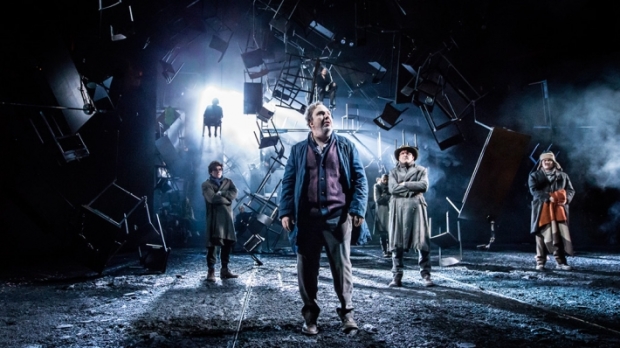Matt Trueman: Set designers are not loonies. They’re artists.
Trueman reflects on the Evening Standard Awards shortlist for best set design and responds to comments made recently about Lizzie Clachan’s design for ”As You Like It” at the National

© Johan Persson
"The design loonies have struck again at the National Theatre." It’s safe to say that the Daily Mail’s Quentin Letts was not a fan of Polly Findlay’s As You Like It and, in particular, of Lizzie Clachan‘s extraordinary design. He wasn’t alone. The Sunday Express dubbed Clachan’s set "hideous" – "the most dismal Forest of Arden in history" – while the Telegraph’s Dominic Cavendish declared it "the theatrical equivalent of a selfie."
Me? I loved it. Clachan’s forest of Arden is a tangled thicket of office furniture. As Rosalind and Celia leave for Arden, the rig rises upwards, dragging desks and chairs into the air, until they hang down in long, knotted strands. They stand in, loosely, for trees – task lamps for branches – but they suggest much more than mere trunks: a world away from the workplace, an office uprooted or exploded, furniture falling from the Twin Towers. They make shadows and angles – a cubist sculpture – that reminded me of Cornelia Parker’s piece Cold Dark Matter – a shed blown apart, suspended like a child’s mobile, frozen mid-blast. "Could we not just have had trees?" moaned the Mail.
Behind the wood, a wall of mirrors makes the desks multiply until the forest seems endless and inescapable. It’s a design that, in tandem with Jon Clark‘s clever lighting, creates an atmosphere: of danger, of darkness, of disorientation. Of death – a place one could unwittingly waste away in. Clachan’s forest is not just Arden, but a kind of non-place – perfect for the sort of confusions and transformations that take place in literature’s forests. Gradually, it blossomed: sprouting the green post-it notes of Orlando’s poetry. Does anyone really still want trees?
British theatre design has been one of the revelations of the last ten years or so. It has made theatre a much more interesting art-form – and yet it is still being misunderstood and misrepresented by critics, who often approach it with scepticism, if not outright suspicion.
Take a look at the Evening Standard’s shortlist for best design, announced last week: Hangmen, Temple and City of Angels – two rooms and a backdrop, basically. Yes, Anna Fleischle‘s Bolton pub was meticulously detailed and richly atmospheric, and its various compartments served the narrative’s pace. Yes, Tim Hatley‘s huge, imposing photograph of St Paul's Cathedral never let you forget the situation at the heart of Temple. And yes, City of Angels looked an absolute treat with its greyscale and technicolour clashes (though Duncan McLean‘s videos and Howard Harrison‘s lighting should share the credit with Rob Jones‘s set.)
But with all due respect to three talented designers, do these designs really represent the best of the last twelve months?
Think, for example, of the infinity chamber Tom Scutt created for A Number, making Caryl Churchill‘s clones multiply in the space. It may not have been the most lavish, picture postcard design, true, but it unlocked the play brilliantly: its laboratory conditions, its privacy, the pressure of the reckoning between father and son.
What about Ian MacNeil‘s Medea design? A broken home, twisted and crumpled by tectonic drift, representative of a relationship gone slowly stale. Its every angle was askew – even the bricks of the theatre’s back wall didn’t quite line up – so that your eyes spin and somersault, never quite able to make sense of the space.
Straightforward rooms can do just as much. Paul Wills‘s resale shop in American Buffalo was, at once, a prehistoric cave, a fortress with barred windows and, with a Jesus statuette onsale and coloured posters that stain the windows, a church of sorts. Globes were dotted here and there, reminders of the world offstage, and a neon green pharmacy blinked overhead, screaming ‘Sanctuary.’
There are countless other examples: Miriam Buether‘s disappearing domestic scene in The Father, Soutra Gilmour‘s watercooler wrestling ring in Bull, Natasha Chivers‘ flashbulb lighting in Fireworks. Lippy. Game. Carmen Disruption.
Design can unlock the ideas behind a play and enchance an audience’s experience of it. From wraparound sets, teetering into immersivity, that allow spaces to swallow audiences into stories, to reconfigured auditoria that disrupt the way we watch, British theatre design is better and bolder than ever. It needs a critical culture to measure up and do it justice. Our designers deserve better than dismissal. They’re not loonies. They’re artists.












